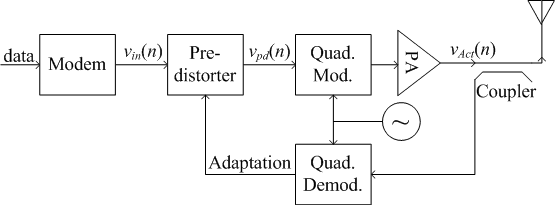Two new blocks and demonstrations have been prepared.
The first of these new blocks and demonstrations has been created to
demonstrate an impairment inherent to achieving efficient high-power
operation in a power amplifier. This demonstration is geared towards
wireless applications, though it is equally relevant to both wireless and
wireline communications. The demonstration illustrates the effect of
an amplifier's variable gain when it operates in its gain compression region, where
clipping occurs but high efficiency is attained. The demonstration was
presented at an ASEE conference and has been documented, and a training
video has been prepared here.
 |
Figure 1.
JDSP Demonstration of RF Amplifier Clipping and Gain Compression |
The second demonstration simulates the correction of
amplifier distortion utilizing the gain-based look-up-table predistortion
algorithm developed by James Cavers [1]. In this algorithm, a local
receiver is used to measure the output transmitted from the power amplifier.
This output is then aligned, and compared to the point the baseband DSP
desired to transmit. Where it is not the desired point, a set of
complex gain correction factors is developed.
 |
Figure 2. Typical
Digital Predistortion Topology. |
The digital predistortion algorithm assumes that the
amplifier gain compression is strictly a function of the amplifier's input
signal power. The algorithm groups input power into bins of a specific
range. These bins are allocated based linearly on input power.
When a point for a given bin is driven by the DSP, the value from the PA
output measured by the receiver is compared to the driven value. A
least-mean-squares algorithm is used to determine the required correction
factor. This correction factor is then applied at the output of the
DSP to distort the signal prior to the amplifier (or pre-distort) it, such
that when the amplifier introduces its distortion the gain achieves the
desired value. As the amplifier has a gain compressive characteristic
for increasing input powers, the predistorter typically has a gain-expansive
characteristic. A J-DSP demonstration of this was prepared and
demonstrated at ASEE. A video tutorial of the demonstration is
available here.
 |
Figure 3.
J-DSP Digital Predistortion Demonstration |
J-DSP Executable:
Click here to access the Power Amplifier JDSP demonstration
platform. (EEE407,EEE455)
Publications:
A. Spanias, R. Santucci, T. Gupta, M. Shah, "Advanced
Functions of Java-DSP For Use in Electrical Engineering and Computer
Engineering Courses",
Proceedings of ASEE, June 2010.
Related Publications:
Santucci, R., Spanias, A., "A
Block Adaptive Predistortion Algorithm for Transceivers with Long
Transmit-Receive Latency," Communications, Control and Signal Processing
(ISCCSP), 2010 4th International Symposium on, pp.1-6, 3-5 March 2010.
Presentations:
Click here for the Power Point slides for ASEE 2010 presentation.
Click here for the Power Point slides for the EEE407 JDSP PA presentation
Click here for the Power Point slides for the EEE455 JDSP PA presentation
Video Tutorials:
J-DSP Amplifier Clipping Video
Tutorial (9MByte WMV file)
J-DSP Digital
Predistortion Video Tutorial (6MByte WMV file)
ASEE2011 Presentation (PowerPoint 2007)
This work is sponsored by the NSF Phase 3 grant
award 0817596 (DWS 0380).




